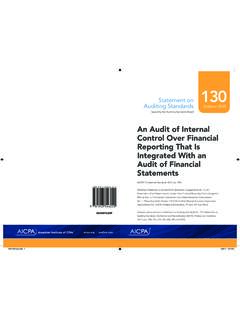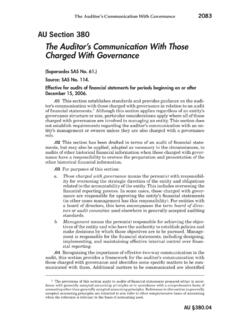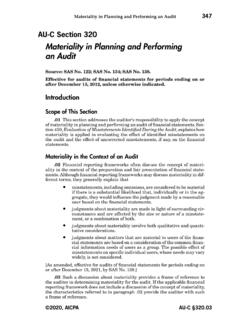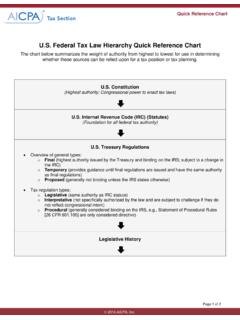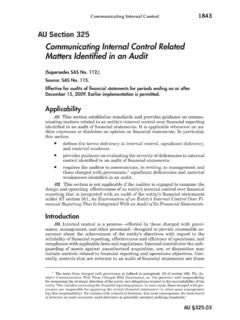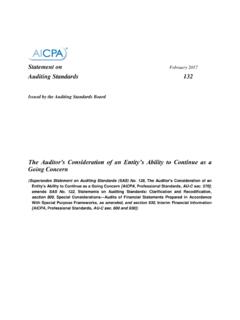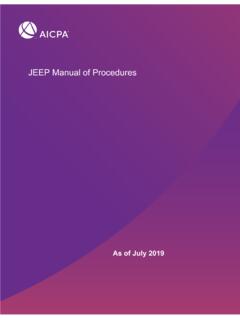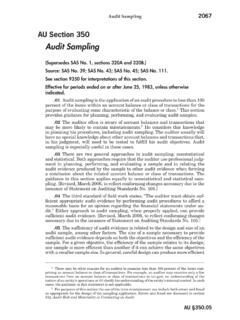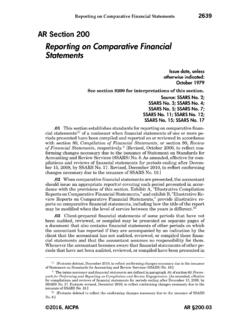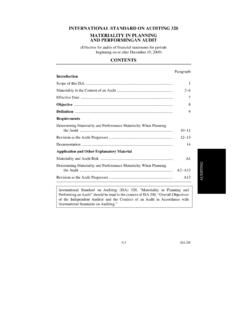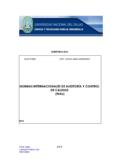Transcription of Evaluation of Misstatements Identified During the Audit
1 Evaluation of Misstatements identified During the Audit399AU-C Section 450 Evaluation of Misstatements identified Duringthe AuditSource: SAS No. 122; SAS No. 134; SAS No. 135; SAS No. 136; SASNo. 137; SAS No. for audits of financial statements for periods ending on orafter December 15, 2012, unless otherwise of This section addresses the auditor's responsibility to evaluate the ef-fect of identified Misstatements on the Audit and the effect of uncorrected mis-statements, if any, on the financial statements. Section 700,Forming an Opin-ion and Reporting on Financial Statements, and section 703,Forming an Opin-ion and Reporting on Financial Statements of Employee Benefit Plans Subjectto ERISA, address the auditor's responsibility in forming an opinion on the fi-nancial statements based on the Evaluation of the Audit evidence obtained. Theauditor's conclusion, required by section 700 or section 703, takes into accountthe auditor's Evaluation of uncorrected Misstatements , if any, on the financialstatements, in accordance with this section.
2 Section 320,Materiality in Plan-ning and Performing an Audit , addresses the auditor's responsibility to appro-priately apply the concept of materiality in planning and performing an Audit offinancial statements. [As amended, effective for audits of financial statementsfor periods ending on or after December 15, 2021, by SAS No. 136.]Effective section is effective for audits of financial statements for periodsending on or after December 15, objective of the auditor is to evaluate the effect Misstatements on the Audit Misstatements , if any, on the financial purposes of generally accepted auditing standards, the followingterms have the meanings attributed as difference between the reported amount, classifi-cation, presentation, or disclosure of a financial statement itemand the amount, classification, presentation, or disclosure that isrequired for the item to be presented fairly in accordance with 2020, AICPAAU-C Assessment and Response to Assessed Risksthe applicable financial reporting framework.
3 Misstatements canarise from fraud or error. (Ref: par..A1) Misstatements also include those adjustments of amounts, clas-sifications, presentations, or disclosures that, in the auditor's pro-fessional judgment, are necessary for the financial statements tobe presented fairly, in all material that the auditor hasaccumulated During the Audit and that have not been corrected.[As amended, effective for audits of financial statements for periods ending onor after December 15, 2021, by SAS No. 134.]RequirementsAccumulation of identified auditor should accumulate Misstatements identified During theaudit, other than those that are clearly trivial. (Ref: par..A2 .A3)Consideration of identified Misstatements as theAudit auditor should determine whether the overall Audit strategy andaudit plan need to be revised nature of identified Misstatements and the circumstancesof their occurrence indicate that other Misstatements may existthat, when aggregated with Misstatements accumulated duringthe Audit , could be material or (Ref: par.)
4 A7) aggregate of Misstatements accumulated During the Audit ap-proaches materiality determined in accordance with section (Ref: par..A8)Communication and Correction of auditor should communicate on a timely basis with the appropri-ate level of management all Misstatements accumulated During the Audit . Theauditor should request management to correct those Misstatements . (Ref: .A11).08If, at the auditor's request, management has examined a class of trans-actions, account balance, or disclosure and corrected Misstatements that weredetected, the auditor should perform additional Audit procedures to determinewhether Misstatements remain. (Ref: par..A12 .A14).09If management refuses to correct some or all of the Misstatements com-municated by the auditor, the auditor should obtain an understanding of man-agement's reasons for not making the corrections and should take that under-standing into account when evaluating whether the financial statements as awhole are free from material (Ref: par.
5 A15 .A18)1 Paragraph .10 of section 320,Materiality in Planning and Performing an .13 of section 700,Forming an Opinion and Reporting on Financial Statements,orparagraph .38 of section 703,Forming an Opinion and Reporting on Financial Statements of EmployeeBenefit Plans Subject to ERISA. [As amended, effective for audits of financial statements for periodsending on or after December 15, 2021, by SAS No. 136.]AU-C 2020, AICPAE valuation of Misstatements identified During the Audit401 Evaluating the Effect of Uncorrected to evaluating the effect of uncorrected Misstatements , the auditorshould reassess materiality3to confirm whether it remains appropriate in thecontext of the entity's actual financial results. (Ref: par..A19 .A21).11 The auditor should determine whether uncorrected Misstatements arematerial, individually or in the aggregate. In making this determination, theauditor should size and nature of the Misstatements , both in relation toparticular classes of transactions, account balances, or disclo-sures and the financial statements as a whole, and the particularcircumstances of their occurrence and (Ref: par.
6 A22 .A29 .A32) effect of uncorrected Misstatements related to prior periodson the relevant classes of transactions, account balances, or dis-closures and the financial statements as a whole. (Ref: par..A30) auditor should include in the Audit documentation4(Ref: par..A33) amount below which Misstatements would be regarded asclearly trivial; (See paragraph .05) Misstatements accumulated During the Audit and whetherthey have been corrected; and (See paragraphs .05 .07) auditor's conclusion about whether uncorrected misstate-ments are material, individually or in the aggregate, and the basisfor that conclusion. (See paragraph .11)Application and Other Explanatory MaterialDefinitionsMisstatement (Ref: par..04).A1 Misstatements may result from fraud or error, such inaccuracy in gathering or processing data from which the fi-nancial statements are prepared; omission of an amount or disclosure, including inadequate orincomplete disclosures and omission of those disclosures requiredto meet disclosure objectives of certain financial reporting frame-works as applicable; financial statement disclosure that is not presented in accor-dance with the applicable financial reporting framework; incorrect accounting estimate arising from overlooking or clearmisinterpretation of facts;3 Paragraph.
7 12 of section .08 .12 and .A8 of section 230, Audit Documentation. 2020, AICPAAU-C Assessment and Response to Assessed of management concerning accounting estimates thatthe auditor considers unreasonable or the selection or applicationof accounting policies that the auditor considers inappropriate; inappropriate classification, aggregation, or disaggregation ofinformation; omission of a disclosure necessary for the financial statementsto achieve fair presentation beyond disclosures specifically re-quired by the examples of Misstatements arising from fraud are provided in section240,Consideration of Fraud in a Financial Statement [As amended,effective for audits of financial statements for periods ending on or after De-cember 15, 2021, by SAS No. 134.]Accumulation of identified Misstatements (Ref: par..05)"Clearly Trivial".A2 Paragraph .05 requires the auditor to accumulate Misstatements iden-tified During the Audit other than those that are clearly trivial.
8 "Clearly trivial"is not another expression for "not material." Misstatements that are clearlytrivial will be of a wholly different (smaller) order of magnitude, or of a whollydifferent nature, than those that would be determined to be material and willbe Misstatements that are clearly inconsequential, whether taken individuallyor in the aggregate and whether judged by any criteria of size, nature, or cir-cumstances. When there is any uncertainty about whether one or more itemsare clearly trivial, the misstatement is considered not to be clearly trivial. [Asamended, effective for audits of financial statements for periods ending on orafter December 15, 2021, by SAS No. 134.] Misstatements in Individual auditor may designate an amount below which misstatementsof amounts in the individual statements would be clearly trivial and wouldnot need to be accumulated because the auditor expects that the accumula-tion of such amounts clearly would not have a material effect on the financialstatements.
9 However, Misstatements of amounts that are above the designatedamount would be accumulated as required by paragraph .05. In addition, mis-statements relating to amounts may not be clearly trivial based on their natureor circumstances and, if not clearly trivial, would be accumulated as requiredby paragraph .05 of this section. [Paragraph added, effective for audits of finan-cial statements for periods ending on or after December 15, 2021, by SAS ] Misstatements in in disclosures may also be clearly trivial whether takenindividually or in the aggregate and whether judged based on size, nature, orcircumstances. Misstatements in disclosures that are not clearly trivial are alsoaccumulated to assist the auditor in evaluating the effect of such misstatementson the relevant disclosures and the financial statements as a whole. provides examples of when Misstatements in qualitative disclosures maybe material.
10 [Paragraph added, effective for audits of financial statements forperiods ending on or after December 15, 2021, by SAS No. 134.]5 Paragraphs .A1 .A8 of section 240,Consideration of Fraud in a Financial Statement 2020, AICPAE valuation of Misstatements identified During the Audit403 Accumulation of by nature or circumstances, accumulated as describedin paragraphs .A3 .A4, cannot be added together as is possible in the case ofmisstatements of amounts. Nevertheless, the auditor is required by to evaluate those Misstatements individually and in the aggregate (that is,collectively with other Misstatements ) to determine whether they are material.[Paragraph added, effective for audits of financial statements for periods endingon or after December 15, 2021, by SAS No. 134.].A6To assist the auditor in evaluating the effect of Misstatements accumu-lated During the Audit and in communicating Misstatements to managementand those charged with governance, the auditor may find it useful to distinguishbetween factual Misstatements , judgmental Misstatements , and projected mis-statements, described as follows: Factual misstatementsare Misstatements about which there is nodoubt.
